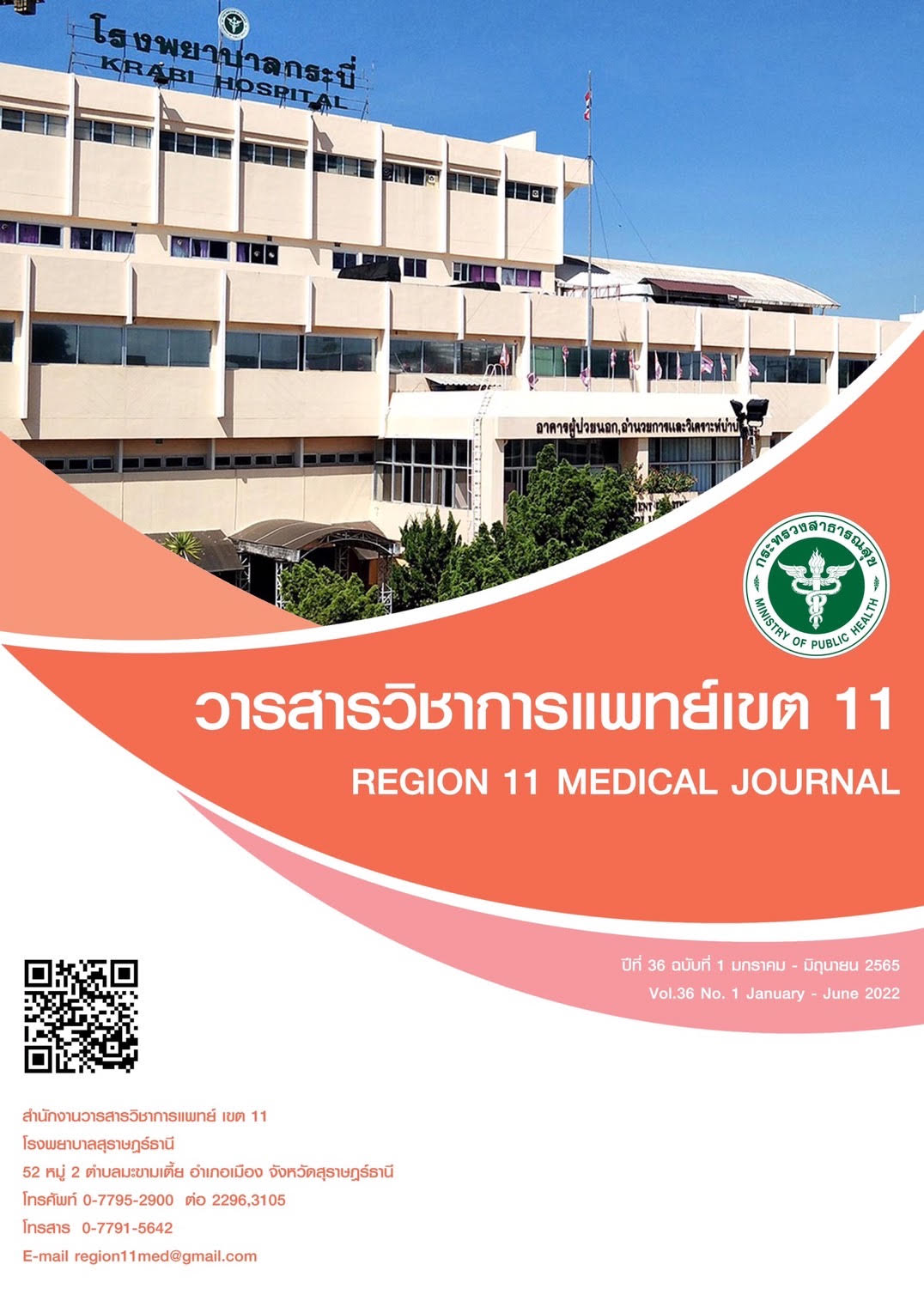The prevalence and risk factors of testosterone deficiency syndrome in Men Health clinic Suratthani hospital
Keywords:
Andropause, Testosterone deficiency syndrome, Prevalence, Risk factorsAbstract
Background: Testosterone deficiency syndrome (TDS) has been defined as a syndrome in middle-aged and elderly men characterized by reduced concentration of serum testosterone. Testosterone deficiency syndrome has been associated with an increase in all-cause mortality and cardiovascular risk. Due to under detection, most of TDS patients have not been treated.
Objective: To estimate the prevalence of TDS and to explore the potential risk factors that associated with testosterone deficiency among Thai men in men health clinic Suratthani hospital.
Method: This is a retrospective cohort study. The data were collected from the suspected testosterone deficiency patients who had visited at men health clinic Suratthani hospital between January 2017 and December 2020.
Result: The 375 patients were included. Prevalence of TDS was found in 78 of 375 patients (20.8%) based on the criteria of testosterone level < 3.0 ng/ml. On univariable analysis, the following parameters which were considered to be significant risk factors for TDS were BMI more than 25 kg/m2 (Odds Ratio [OR] 2.02, 95% Confidence Interval [CI] 1.18-3.46, p-value 0.007), waist circumference greater than 90 cm (OR 2.21, 95%CI 1.26-3.83, p-value 0.005), Diabetic mellitus (OR 1.96, 95%CI 1.00-3.73, p-value 0.038), HDL less than 40 mg/dl (OR 2.78, 95%CI 1.38-5.78, p-value 0.003) and triglyceride more than 150 mg/dl (OR 2.00, 95%CI 1.03-3.87, p-value 0.036). On multivariable analysis, the independent risk factor associated with TDS was HDL less than 40 mg/dl (OR 2.38, 95%CI 1.15-4.93, p-value 0.02)
Conclusion: Prevalence of testosterone deficiency syndrome in Thai male patient in men health clinic Suratthani hospital is 20.8%. Testoseterone deficiency syndrome was associated with HDL less than 40 mg/dl.
References
Lunenfeld B, Mskhalaya G, Zitzmann M, Arver S, Kalinchenko S, Tishova Y, et al. Recommendations on the diagnosis, treatment and monitoring of hypogonadism in men. Aging Male. 2015;18(1):5-15.
Khera M, Adaikan G, Buvat J, Carrier S, El-Meliegy A, Hatzimouratidis K, et al. Diagnosis and Treatment of Testosterone Deficiency: Recommendations From the Fourth International Consultation for Sexual Medicine (ICSM 2015). J Sex Med. 2016;13(12):1787-804.
Tsujimura A. The Relationship between Testosterone Deficiency and Men's Health. World J Mens Health. 2013;31(2):126-35.
Zarotsky V, Huang MY, Carman W, Morgentaler A, Singhal PK, Coffin D, et al. Systematic literature review of the risk factors, comorbidities, and consequences of hypogonadism in men. Andrology. 2014;2(6):819-34.
Wu FC, Tajar A, Beynon JM, Pye SR, Silman AJ, Finn JD, et al. Identification of late-onset hypogonadism in middle-aged and elderly men. N Engl J Med. 2010;363(2):123-35.
Ding EL, Song Y, Malik VS, Liu S. Sex differences of endogenous sex hormones and risk of type 2 diabetes: a systematic review and meta-analysis. JAMA. 2006;295(11):1288-99.
Wang C, Nieschlag E, Swerdloff R, Behre HM, Hellstrom WJ, Gooren LJ, et al. Investigation, treatment and monitoring of late-onset hypogonadism in males: ISA, ISSAM, EAU, EAA and ASA recommendations. European journal of endocrinology / European Federation of Endocrine Societies. 2008;159(5):507-14.
Stanworth RD, Jones TH. Testosterone for the aging male; current evidence and recommended practice. Clinical interventions in aging. 2008;3(1):25-44.
Nieschlag E, Swerdloff R, Behre HM, Gooren LJ, Kaufman JM, Legros JJ, et al. Investigation, treatment, and monitoring of late-onset hypogonadism in males: ISA, ISSAM, and EAU recommendations. J Androl. 2006;27(2):135-7.
Muller M, Grobbee DE, den Tonkelaar I, Lamberts SW, van der Schouw YT. Endogenous sex hormones and metabolic syndrome in aging men. J Clin Endocrinol Metab. 2005;90(5):2618-23.
Haring R, Ittermann T, Volzke H, Krebs A, Zygmunt M, Felix SB, et al. Prevalence, incidence and risk factors of testosterone deficiency in a population-based cohort of men: results from the study of health in Pomerania. Aging Male. 2010;13(4):247-57.
Morgentaler A, Traish A, Hackett G, Jones TH, Ramasamy R. Diagnosis and Treatment of Testosterone Deficiency: Updated Recommendations From the Lisbon 2018 International Consultation for Sexual Medicine. Sex Med Rev. 2019;7(4):636-49.
Kapoor D, Aldred H, Clark S, Channer KS, Jones TH. Clinical and biochemical assessment of hypogonadism in men with type 2 diabetes: correlations with bioavailable testosterone and visceral adiposity. Diabetes Care. 2007;30(4):911-7.
Harman SM, Metter EJ, Tobin JD, Pearson J, Blackman MR, Baltimore Longitudinal Study of A. Longitudinal effects of aging on serum total and free testosterone levels in healthy men. Baltimore Longitudinal Study of Aging. J Clin Endocrinol Metab. 2001;86(2):724-31.
Akinloye O, Blessing Popoola B, Bolanle Ajadi M, Gregory Uchechukwu J, Pius Oparinde D. Hypogonadism and metabolic syndrome in nigerian male patients with both type 2 diabetes and hypertension. Int J Endocrinol Metab. 2014;12(1):e10749.
Morley JE, Charlton E, Patrick P, Kaiser FE, Cadeau P, McCready D, et al. Validation of a screening questionnaire for androgen deficiency in aging males. Metabolism. 2000;49(9):1239-42.
Grundy SM, Cleeman JI, Merz CN, Brewer HB, Jr., Clark LT, Hunninghake DB, et al. Implications of recent clinical trials for the National Cholesterol Education Program Adult Treatment Panel III guidelines. Circulation. 2004;110(2):227-39.
Downloads
Published
How to Cite
Issue
Section
License
Copyright (c) 2022 Region11Medical Journal

This work is licensed under a Creative Commons Attribution-NonCommercial-NoDerivatives 4.0 International License.






